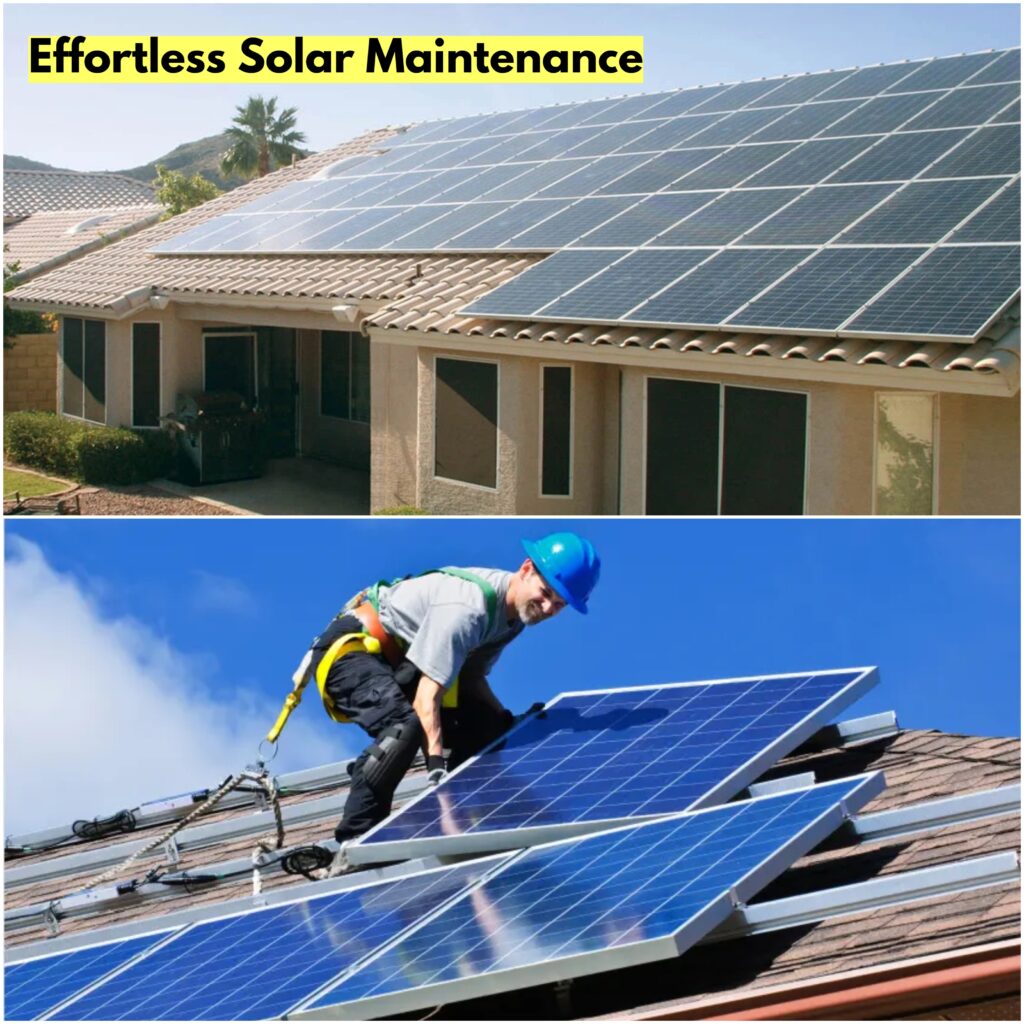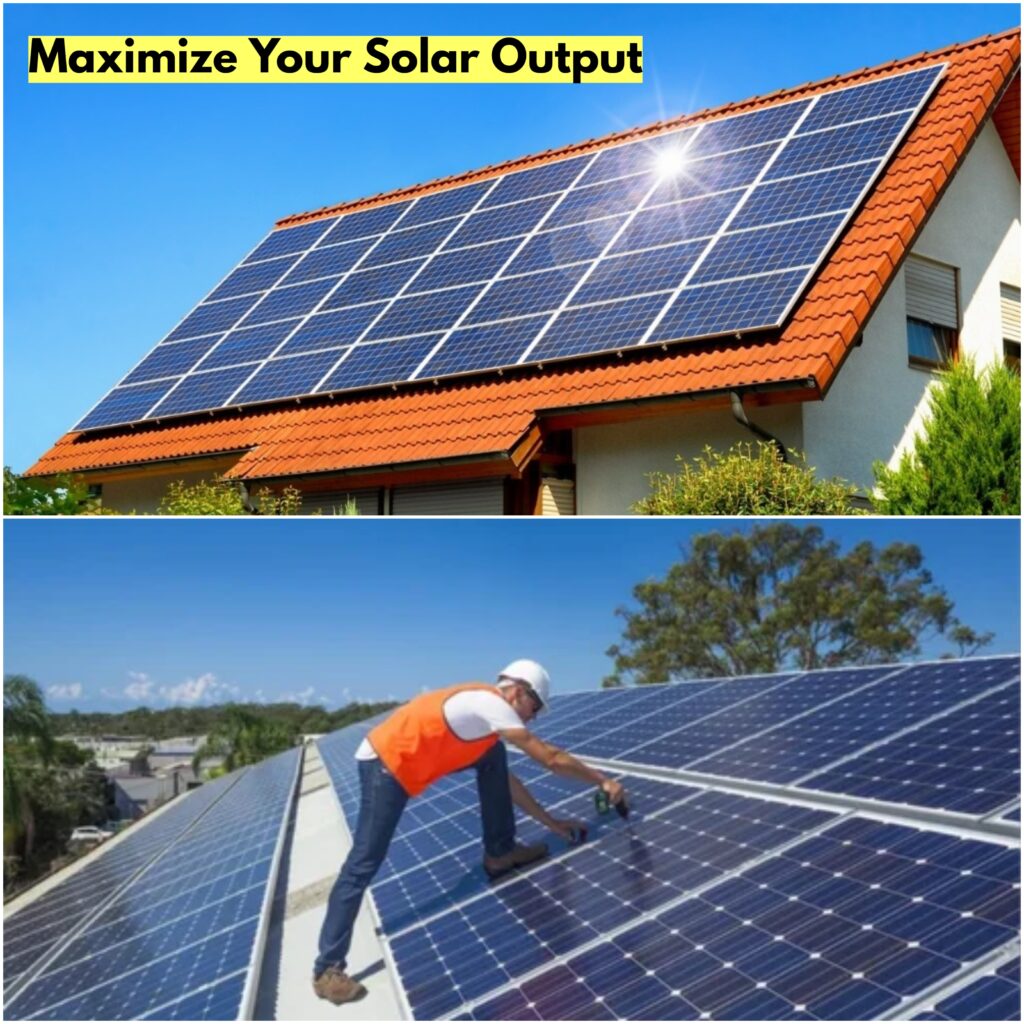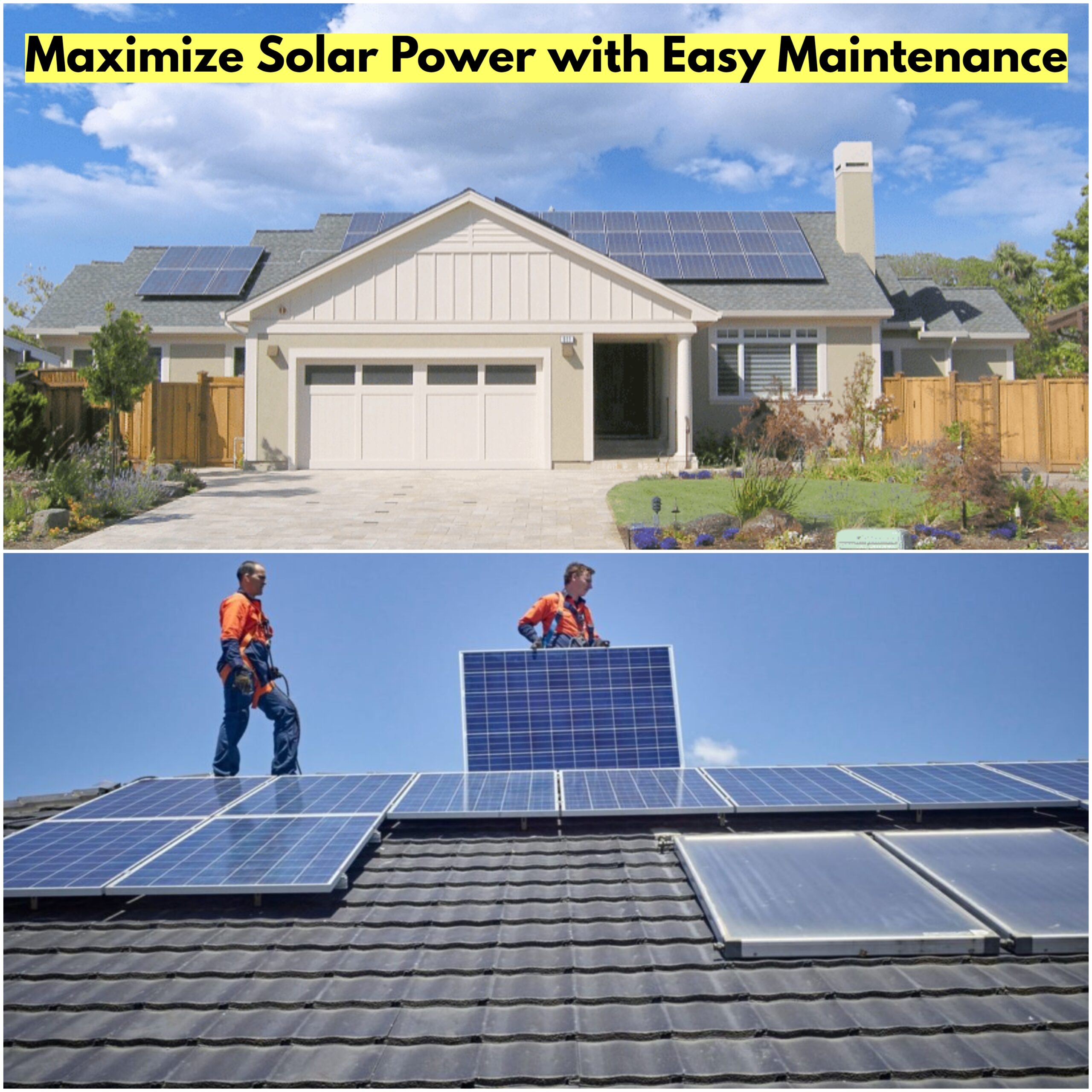Households in the USA are increasingly choosing solar energy. More American families are using home solar panels as a reliable and environmentally responsible solution as a result of growing energy bills and an increasing focus on sustainable living.
In 2024 alone, the United States added more than 30 gigawatts of solar capacity, powering millions of homes around the country, according to current statistics.
This increase indicates how highly Americans consider renewable energy for its positive effects on the economy and the environment.
But putting home solar panels alone is insufficient. To keep them operating effectively and maintain their lifespan, proper maintenance is necessary.
Frequent maintenance guarantees that your investment will continue to save the most energy and contribute to environmental protection.

How to Maintain Your Home Solar Panels?
A) Types of Solar Panels
Learning what type of home solar panels you have is useful before beginning any maintenance.
The most popular types are,
- Monocrystalline Solar Panels
These panels are composed of a single crystal structure and are popular for their efficiency and elegant design. For houses with a small roof, they are ideal.
- Polycrystalline Solar Panels
These are more affordable but marginally less effective because they are composed of several crystal fragments.
- Thin-Film Solar Panels
These panels are flexible and lightweight, making them perfect for unusual surfaces.
Yet, their efficiency is usually lower than that of the other two types.
B) How Home Solar Panels Work?
Through their photovoltaic cells, solar panels capture sunlight and transform it into direct current (DC) electricity.
After passing through an inverter, this energy is transformed into alternating current (AC) electricity, which powers your house.
The panels will receive the most sunlight if they are kept clean and maintained.
C) Why Maintenance Matters?
Maintaining the efficiency of your home solar panels requires regular maintenance. Debris, dust, and dirt may block sunlight, which lowers energy production.
Your panels’ lifespan may be shortened by long-term damage brought on by neglecting maintenance.
You can prevent expensive repairs and lower your energy costs by maintaining home solar panels.
Regular Cleaning of Solar Panels
A) Why Clean Your Panels?
Dust, dirt, and even bird droppings can build up on home solar panels over time, blocking sunlight and decreasing the panel’s efficiency.
The amount of energy produced can be significantly reduced by even a thin covering of dirt.
Maintaining your panels’ optimal performance through routine cleaning can maximize your energy savings.
B) How Often Should You Clean?
Depending on where you live in the USA, cleaning frequency varies,
- Dry and Dusty Areas (e.g., Arizona, Nevada): To avoid buildup of dust; clean your panels every two to three months.
- Rainy or Humid Areas (e.g., Florida, Oregon): You might only need to check them twice a year because nature usually takes care of the cleaning.
- Urban or High-Pollution Areas: To get rid of pollution and dirt buildup, clean every 3 months.
C) Step-by-Step Cleaning Process
- Turn Off the Solar Power System: Always turn off home solar panel system before cleaning for increased safety.
- Use a Soft Brush or Sponge with Water: Use a non-abrasive sponge and clean water to gently scrub the panels to get rid of any dirt.
- Avoid Abrasive Materials and Harsh Chemicals: Never use detergents that could harm the surface, harsh cleaners, or sharp objects.
D) Tools to Use
Purchasing a cleaning kit for home solar panels might simplify the procedure.
Typically, these kits come with a biodegradable soap, squeegee, and soft brush that are all made to be friendly to your panels.
Online or at home improvement retailers like Lowe’s and Home Depot, you can find cheap solutions.
Read: How to Keep Your Home Roof in Excellent Condition?

Inspect Solar Panels for Damage
A) Visual Inspections
You may identify possible problems with home solar panels early on by visually inspecting them.
Look for,
- Cracks or Chips: Weather-related occurrences like hail or falling debris might cause this.
- Discoloration: Brown or yellow patches could be a sign of electrical problems or overheating.
- Loose Connections: Look for any parts or wires that seem broken or disconnected.
Immediate resolution of these issues can ensure peak performance and stop more harm.
B) Frequency of Inspections
It is best to perform seasonal inspections, which means you should inspect your panels at least twice a year.
Check your panels for physical damage following extreme weather conditions such as storms or heavy snowfall.
C) What to Do If You Spot Issues?
Avoid DIY repairs if you see any damage or anomalies.
Speak with a qualified solar specialist to diagnose and resolve the issue.
In the USA, a lot of expert services focus on fixing home solar panels and provide maintenance plans to keep your system operating at its best.
Prompt action is essential because ignoring minor problems can later result in expensive repairs.
Monitor Home Solar Panel Performance
A) Track Energy Output
Monitoring the energy production of your home solar panels is one of the simplest ways to make sure they are operating well.
A lot of solar systems have inverters or monitoring apps that let you see how much energy your panels are producing in real time.
These tools help you identify problems early and provide you with a clear view of how well your system is doing.
B) Signs of Declining Performance
- Sudden Drops in Energy Production: Dirt, shade, or possible damage may be the cause of a sudden drop in energy generation.
- Inverter Errors: If there is a problem with your inverter, it may frequently display error codes. For troubleshooting, pay attention to these and consult your user manual.
- Increased Energy Bills: It is time to check if your system is operating correctly if your energy costs continue to rise even with home solar panels installed.
C) USA-Specific Tools
In the USA, there are many techniques available to monitor and improve the performance of home solar panels,
- SolarEdge Monitoring App: The well-known SolarEdge Monitoring App lets you track maintenance, identify issues, and keep an eye on how much energy your system is producing.
- Enphase Enlighten: This software makes troubleshooting simple by providing extensive knowledge into the functionality of each individual panel.
- Tesla Powerwall: If you have energy storage, you can track solar energy production and stored energy in real time with Tesla’s Powerwall system.
These commonly used tools help make sure your solar panels keep operating at their peak performance, which maximizes efficiency and saves you money.
Read: How to Care for Your Home Vinyl Siding?
Protect Home Solar Panels from Extreme Weather
A) Seasonal Considerations
It is necessary to shield home solar panels from the damaging effects of severe weather all year long if you want them to remain in optimal condition.
What to do in the various seasons is as follows,
1. Summer
- Make sure there is enough airflow beneath your panels.
- Even a small amount of shade can have an impact on performance, so look for any shading problems.
2. Winter
- Your panels can build up snow and ice, which would block sunlight and lower their energy output.
- Make use of a snow rake made especially for solar panels or a soft brush. To prevent harming the panels or scratching the surface, use caution.
- It might be advisable to hire a professional to remove the snow if it is too thick.
3. Fall
- Leaves and other debris from surrounding trees might build up on your panels in the fall.
- Keep leaves and other debris away from your panels on a regular basis since they can block sunlight and lower energy production.
B) Protection Measures
You can take a few more precautions to shield your solar panels from severe weather in addition to seasonal cleaning,
- Weatherproof Covers: To protect your panels from the elements, especially in regions that frequently experience storms or severe snowfall, think about investing in weatherproof covers.
- Surge Protectors: To prevent damage to home solar panels from power surges or lightning strikes, install a surge protector.
You can increase the lifespan of your solar panels and make sure they continue to function well whatever the weather by following these measures.
Read: Maintaining Your Home Water Filtration System

Maintenance of Surrounding Areas
A) Trimming Trees
- Making sure the surroundings are kept up is the most important component of maintaining solar panels.
- Trees that are too close to solar panels may block sunlight and create shadows, which lower their effectiveness.
- By keeping trees and bushes trimmed on a regular basis, you may avoid shade and maximize the amount of sunshine your panels receive.
- Also, overgrown branches can damage your panels, particularly in windy or stormy conditions.
- You can avoid harm from falling limbs by keeping branches clipped and away from the panels.
B) Clearing Debris Around Panels
- It is also necessary to clear the area around your solar panels.
- Debris such as leaves and twigs can gather around the panels, obstructing sunlight and lowering the energy production.
- Make it a practice to check the area surrounding the panels and clear away any debris or leaves that may have built after storms or windy days.
- Your panels will be able to continue operating at their peak efficiency if you do this easy task.
C) Roof Integrity
- Verifying the integrity of the roof where the panels are installed is another essential maintenance activity.
- A broken roof might cause problems like leaks or structural instability and make it more difficult to install the solar panels.
- Check your roof frequently for wear indicators like leaks, loose shingles, or other damage.
- It is necessary to fix any issues discovered before replacing or installing your solar panels.
Your solar panel system’s longevity and effectiveness will be preserved if you keep your roof in good shape.
DIY Maintenance Tips for Home Solar Panel Owners in the USA
A) Safety First
- Safety should always come first while maintaining home solar panels.
- Turn off your solar system before beginning any cleaning, maintenance, or repairs.
- This will reduce the possibility of electric shock or system damage while you are working on it.
- Additionally, take suitable precautions to prevent falls or mishaps when using ladders or climbing to the roof.
- Always follow by safety precautions, and if you are not sure, think about getting help from an expert.
B) Use of Eco-Friendly Products
- Using eco-friendly cleaning solutions that do not harm the system or the environment is important when cleaning your solar panels.
- In addition to damaging the panels, harsh chemicals can harm nearby ecosystems. Use gentle cleaning agents that follow to environmental regulations and biodegradable soaps.
- In states where sustainability is a top focus, doing this guarantees that you are not just maintaining your panels but also conforming by local environmental laws.
C) Simple Preventive Measures
- It is not necessary for routine maintenance to be difficult.
- Simple yet efficient methods to maintain the best possible condition for your home solar panels include setting up a cleaning routine and making a basic inspection checklist.
- Depending on your local climate, you should aim to clean your panels at least once or twice a year, if not more frequently.
- Every few months, conduct simple visual checks to look for visible damage, loose connections, and dirt buildup.
- Your system will continue to function properly for many years to come with these minor, regular efforts.

Bottom Line
Future developments in home solar panel technology, including self-cleaning panels, are being planned. These developments may make solar panel maintenance even simpler and more effective, increasing the accessibility and sustainability of solar energy for American homeowners.
Read: Bathroom Renovations That Add the Most Value to Your Home











